OLDER THAN DIRT.
Guaranteed Authentic.
Ancient Coins & Artifacts:
|
|
|
Moon Rock and Mars Rock For Sale
Yes these are REAL and certified!
Presented in a removable display box with certificate of authenticity and ID card
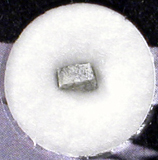 The moon is regularly struck by meteorites which eject lunar rocks into space. With the right trajectory, some of this material gets caught by earth's gravitational pull and falls as a meteorite down to earth. Not long ago it was simply impossible to own a piece of the moon. The very first lunar meteorite in private hands was the small Calcalong Creek find – it was first sold in small slices during the second half of the 1980's. The going price was $1,300,000 USD per gram. The next two lunar discoveries were made in the late 1990's. DaG 400 & DaG 262 – and the asking prices were still $200,000 – $250,000 a gram. Hence a small piece like the inexpensive specimens offered here would have cost $2000-$3000 only a decade ago. The moon is regularly struck by meteorites which eject lunar rocks into space. With the right trajectory, some of this material gets caught by earth's gravitational pull and falls as a meteorite down to earth. Not long ago it was simply impossible to own a piece of the moon. The very first lunar meteorite in private hands was the small Calcalong Creek find – it was first sold in small slices during the second half of the 1980's. The going price was $1,300,000 USD per gram. The next two lunar discoveries were made in the late 1990's. DaG 400 & DaG 262 – and the asking prices were still $200,000 – $250,000 a gram. Hence a small piece like the inexpensive specimens offered here would have cost $2000-$3000 only a decade ago.
Now nearly everyone can afford their piece of Moon or Mars. However, Lunar and Martian meteorites are found only in desert regions and in recent years, more desert countries where they are found pass strict laws controlling their export. With no new finds being made (or at least released to the public) the pieces offered here are among the last that will be available for quite some time.
Scientists and universities examine meteorites and compare them with known lunar material, including samples collected by astronauts during the Apollo missions. The composition of gases and isotopes is unique to only one source, and the material can be identified with certainty as originating from the surface of the moon. This particular lunar meteorite was classified by Dr. Irving and Dr. Korotev and is currently being studied at Washington University, St. Louis. More information on this study found at the university website here.
|
MOON ROCKS
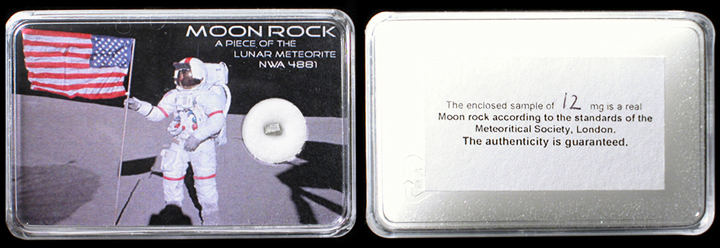 Moon Rock! Lunar gabbro meteorite, actual piece of rock from the surface of the moon! The moon is regularly struck by meteorites which eject lunar rocks into space. With the right trajectory, some of this material gets caught by earth's gravitational pull and falls as a meteorite down to earth. This particular lunar meteorite was first discovered in July 2006 in Algeria and was classified by Dr. A. Irving and S. Kuehner, UWS. Found were just twelve broken fragments of very fine-grained, pale grey rock with a combined weight of 208 g. NWA 4483 is published in Meteoritical Bulletin, no. 94, MAPS 43, 1551-1588 (2008). It is currently being studied further at the University of Washington, Department of Earth and Space Sciences, Seattle, WA. Each specimen measures around 2-3 mm and weighs between 7 and 12 mg. Boxes measure 2 1/4" x 1 3/8". Every specimen is unique but similar in size and appearance. The one you will receive might be slightly different and not necessarily the same as pictured. Box designs and specific lunar specimens vary (NWA4881 example shown).
Moon Rock! Lunar gabbro meteorite, actual piece of rock from the surface of the moon! The moon is regularly struck by meteorites which eject lunar rocks into space. With the right trajectory, some of this material gets caught by earth's gravitational pull and falls as a meteorite down to earth. This particular lunar meteorite was first discovered in July 2006 in Algeria and was classified by Dr. A. Irving and S. Kuehner, UWS. Found were just twelve broken fragments of very fine-grained, pale grey rock with a combined weight of 208 g. NWA 4483 is published in Meteoritical Bulletin, no. 94, MAPS 43, 1551-1588 (2008). It is currently being studied further at the University of Washington, Department of Earth and Space Sciences, Seattle, WA. Each specimen measures around 2-3 mm and weighs between 7 and 12 mg. Boxes measure 2 1/4" x 1 3/8". Every specimen is unique but similar in size and appearance. The one you will receive might be slightly different and not necessarily the same as pictured. Box designs and specific lunar specimens vary (NWA4881 example shown).
Moon rocks #MR-NWA4483 : $100 each. Only a few available!
|
MARS ROCKS
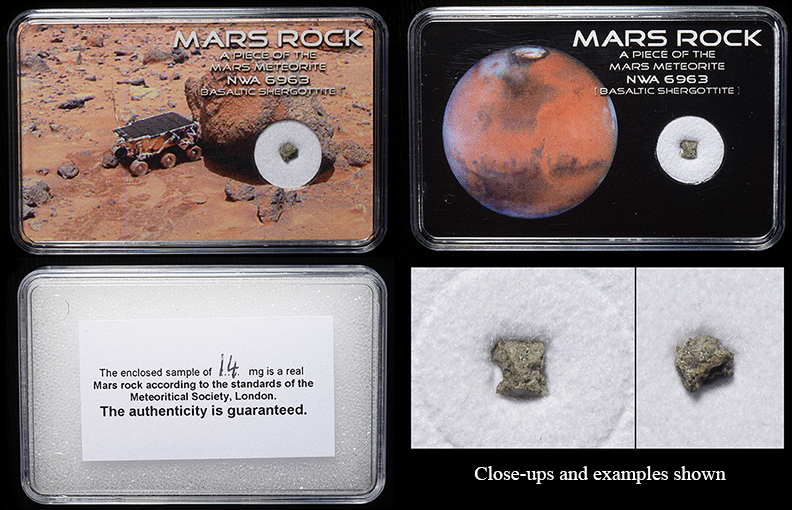 Mars Rock! Martian meteorite NWA 4766. Actual piece of rock from the surface of Mars! Mars is occasionally struck by meteorites which ejects Martian surface material into space. A very small amount of this material gets caught by earth's gravitational pull and falls as a meteorite down to earth. This is a fragment of Martian basalt (“Diabasic shergottite”) from the Martian meteorite known as NWA 4766, found in 2007 in Tagounite, Morocco, Northwest Africa, and was classified by Dr. A. Greshake, MNB. Published in Meteoritical Bulletin, no. 108 (2019). It is currently being studied by the Museum für Naturkunde, Berlin, Germany. Each specimen measures around 2-3 mm and weighs between 7 and 12 mg. Boxes measure 2 1/4" x 1 3/8". Every specimen is unique but similar in size and appearance. The one you will receive might be slightly different and not necessarily the same as pictured. Box designs vary (example styles shown).
Mars Rock! Martian meteorite NWA 4766. Actual piece of rock from the surface of Mars! Mars is occasionally struck by meteorites which ejects Martian surface material into space. A very small amount of this material gets caught by earth's gravitational pull and falls as a meteorite down to earth. This is a fragment of Martian basalt (“Diabasic shergottite”) from the Martian meteorite known as NWA 4766, found in 2007 in Tagounite, Morocco, Northwest Africa, and was classified by Dr. A. Greshake, MNB. Published in Meteoritical Bulletin, no. 108 (2019). It is currently being studied by the Museum für Naturkunde, Berlin, Germany. Each specimen measures around 2-3 mm and weighs between 7 and 12 mg. Boxes measure 2 1/4" x 1 3/8". Every specimen is unique but similar in size and appearance. The one you will receive might be slightly different and not necessarily the same as pictured. Box designs vary (example styles shown).
Mars rocks #MR-NWA4766 : $150 each. Only a few available!
|
|
|
|
|
|
Every item comes with a 100% Lifetime Guarantee of Authenticity.
To make a purchase, or for more information, CLICK HERE
|
|
All contents (C) 2003-2025 AD. All rights reserved.
Owned, Operated, and Obsessed Upon by Gabriel Vandervort.
Reproduction without permission is prohibited.
|
|
| Related search topics: moon rock for sale, Mars rocks for sale, extra terrestrial rocks for sale, meteors meteorites for sale, Los Angeles |
|
|

|
Size
|
Weight (in grams)
|
Price
|
|
XS
|
<0.02g
|
$80 (sold out)
|
| S |
0.02g - 0.035g |
$100 (sold out) |
| M |
0.035g - 0.055g |
$150 (sold out) |
| L |
0.055g - 0.065g |
$200 (sold out) |
Examples are shown below. Display boxes measure 2 3/16" x 1 3/8". The prices are by gram... rates as follows:
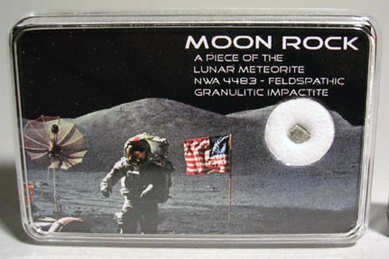
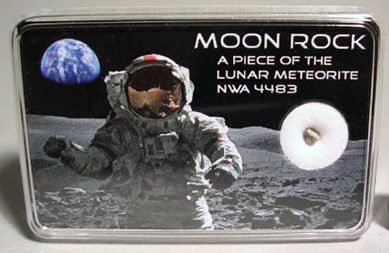
NWA 4481 is a lunar gabbro meteorite that contains two pyroxenes, olivine, plagioclase shocked to maskelynite, K, Ba feldspar, and various Cr, Fe, Ti oxides. This cumulate lunar rock (cumulate = accumulation of crystals by gravity settling in a magma) probably originated in the lunar highlands environment as a thick lava flow or as a shallow intrusive into the highlands crust. After formation, the gabbro was moderately shocked by hypervelocity impact.
#MR-NWA4881: $80
|
Size
|
Weight (in grams)
|
Price
|
|
XS
|
<0.02g
|
$80
|
| S |
0.02g - 0.035g |
$100 (sold out) |
| M |
0.035g - 0.055g |
$150 (sold out) |
| L |
0.055g - 0.065g |
$200 (sold out) |
|
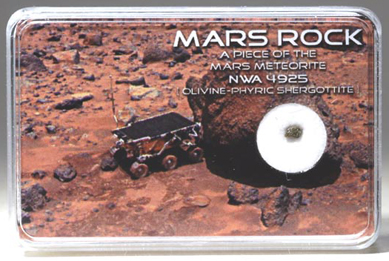
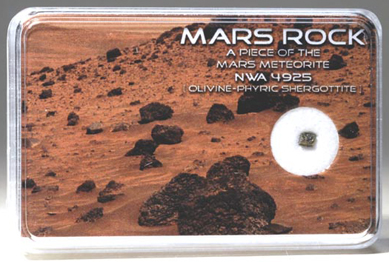
Mars is occasionally struck by meteorites which ejects Martian surface material into space. A very small amount of this material gets caught by earth's gravitational pull and falls as a meteorite down to earth.
NWA 4925. Found in 2007, Libya
Martian basalt (olivine-phyric shergottite)
|
Size
|
Weight (in grams)
|
Price
|
|
XS
|
<0.02g
|
$50 (sold out)
|
| S |
0.02g - 0.035g |
$100 (sold out) |
| M |
0.035g - 0.055g |
$150 (sold out) |
| L |
0.055g - 0.065g |
$200 (sold out) |
The meteorite displays a porphyritic texture with large chemically zoned olivine megacrysts set into a fine-grained groundmass composed of pyroxene and maskelynite. Minor phases include chromite, sulfides, phosphates, and small Fe-rich olivines. The olivine megacrysts often contain melt inclusions and small chromites.
Geochemistry: Mineral compositions as determined by EMP: olivine, Fa 27.6-46.8; pyroxene, Fs 20.0-37.7 Wo 3-14.8; maskelynite, An 67-69. Classification: Achondrite (Martian, olivine-phyric shergottite); severely shocked with some melt pockets; moderately weathered.
Specimens: A total of 20.1 g plus one polished thin section are on deposit at MNB. Stefan Ralew, Kunibertstrasse 29, 12524 Berlin, Germany holds the main mass.
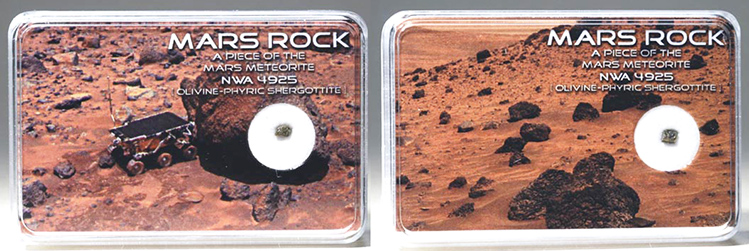
|
Moon Rock: $220 (Sold)
NWA 2977 Lunar meteorite specimen
OFFICIAL CLASSIFICATION
NOTE: This meteorite is currently being studied by Northern Arizona University and the University of Washington. Gabbro type Lunar specimens are RARE and expensive.
NWA 2977 is a lunar gabbro meteorite that contains two pyroxenes, olivine, plagioclase shocked to maskelynite, K, Ba feldspar, and various Cr, Fe, Ti oxides. This cumulate lunar rock (cumulate = accumulation of crystals by gravity settling in a magma) probably originated in the lunar highlands environment as a thick lava flow or as a shallow intrusive into the highlands crust. After formation, the gabbro was moderately shocked by hypervelocity impact.
.044 grams and measures 5.0mm by 3.5mm by .9mm thick. A GREAT surface to weight ratio.
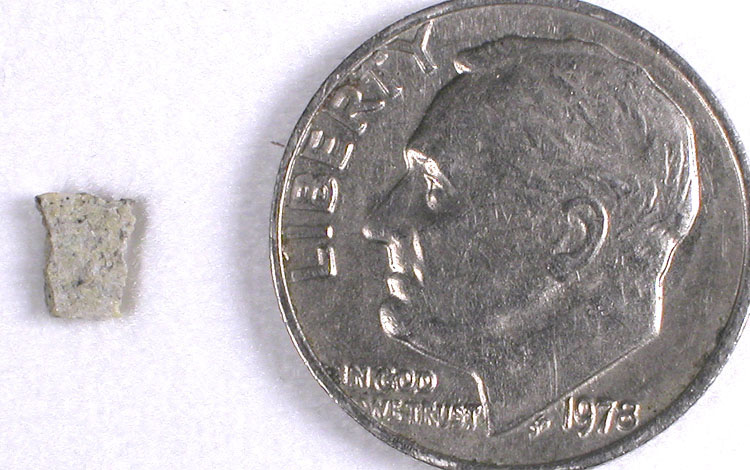
Background and scientific info: The original recovered material was a shiny, dark, 83 g fusion-crusted stone found in three pieces. The interior shows abundant maskelynite and shock melt vein. Microprobe examination of a polished epoxy mount shows 60% pyroxene, 35% maskelynite, 2% ulvöspinel, 2% melt pockets with silica, minor merrillite, trace chlorapatite and pyrrhotite. Classification: Achondrite (Martian, shergottite); minimal weathering, high shock grade based on complete transformation of plagioclase to maskelynite.
Display boxes measure 2 3/16" x 1 3/8". All weigh between 10 to 17 mg, and measure around 2 mm.
Box designs vary (example styles shown).
JUST A COUPLE LEFT! Mars rocks #MR-NWA6963: $100 each.
MOON ROCKS
 NWA 4881 is a lunar gabbro meteorite that contains two pyroxenes, olivine, plagioclase shocked to maskelynite, K, Ba feldspar, and various Cr, Fe, Ti oxides. This cumulate lunar rock (cumulate = accumulation of crystals by gravity settling in a magma) probably originated in the lunar highlands environment as a thick lava flow or as a shallow intrusive into the highlands crust. After formation, the gabbro was shocked by hypervelocity impact and sent hurtling toward Earth. Display boxes measure 2 3/16" x 1 3/8".
NWA 4881 is a lunar gabbro meteorite that contains two pyroxenes, olivine, plagioclase shocked to maskelynite, K, Ba feldspar, and various Cr, Fe, Ti oxides. This cumulate lunar rock (cumulate = accumulation of crystals by gravity settling in a magma) probably originated in the lunar highlands environment as a thick lava flow or as a shallow intrusive into the highlands crust. After formation, the gabbro was shocked by hypervelocity impact and sent hurtling toward Earth. Display boxes measure 2 3/16" x 1 3/8".
All weigh between 7 to 14 mg, and measure around 2 mm. Box designs vary (example shown).
Moon rocks #MR-NWA4881: $150 each. Only a few available!
MARS ROCKS
Actual piece of rock from the surface of Mars!
Mars is occasionally struck by meteorites which ejects Martian surface material into space.
A very small amount of this material gets caught by earth's gravitational pull and falls as a meteorite down to earth.
Offered here are fragments of Martian basalt from the Martian meteorite known as NWA 4925, found in 2007, Northwest Africa.

Background and scientific info: The original recovered material was a shiny, dark, 83 g fusion-crusted stone found in three pieces. The interior shows abundant maskelynite and shock melt vein. Microprobe examination of a polished epoxy mount shows 60% pyroxene, 35% maskelynite, 2% ulvöspinel, 2% melt pockets with silica, minor merrillite, trace chlorapatite and pyrrhotite. Classification: Achondrite (Martian, shergottite); minimal weathering, high shock grade based on complete transformation of plagioclase to maskelynite.
Display boxes measure 2 3/16" x 1 3/8". All weigh between 10 to 17 mg, and measure around 2 mm.
Box designs vary (example styles shown).
JUST A COUPLE LEFT! Mars rocks #MR-NWA4925: $150 each. Only a few available!
|
Mars Rock: $299
DAG 476 Martian basalt specimen(Sold)
OFFICIAL CLASSIFICATION:
DAG 476. Found 1998 May 1, Libya. Martian basalt (shergottite)
A brownish stone weighing 2015 g was found in Dar al Gani, Sahara. Mineralogy and classification (J. Zipfel and P. Scherer, MPI): fusion crust absent; meteorite has a porphyritic texture, consisting of olivine embedded in a fine-grained matrix of clinopyroxene laths (pigeonite and minor augite) and interstitial feldspathic glass; mineral abundances similar to EET 79001 lithology A; Fe-sulfide, Ti-rich chromites, ilmenite and chromite present; shock features include twinning and fracturing of clinopyroxene, mosaicism of some olivine, and plagioclase converted to feldspathic glass; impact-melt pockets abundant; extensive terrestrial weathering resulted in carbonate veins crosscutting the meteorite along grain boundaries and cracks; bulk chemistry intermediate between basaltic and lherzolitic shergottites, with a high bulk Mg/(Mg + Fe), high concentrations of siderophile elements, relatively low abundances of heavy rare earth elements (HREE), and a strong light rare earth element (LREE) depletion; exposure age 1.1 ± 0.2 Ma; 36Ar/132Xe and 84Kr/132Xe typical of Martian meteorites, and 129Xe/132Xe similar to Chassigny. Oxygen isotopes (I. Franchi, OU): d18O = 4.57, d17O = 2.69‰ rel. SMOW (D17O = 0.317). The petrography, mineralogy, and noble gas chemistry of DaG 476 and DaG 489 are very similar, and the two are likely paired (L. Folco, MNA-SI, and J. Zipfel and L. Schultz, MPI).
Published in Meteoritical Bulletin, no. 83, MAPS 34, A169-A186 (1999)
.064 grams and measures 5.2mm by 4.2mm by 1.0mm thick at widest points. Great surface to weight ratio!
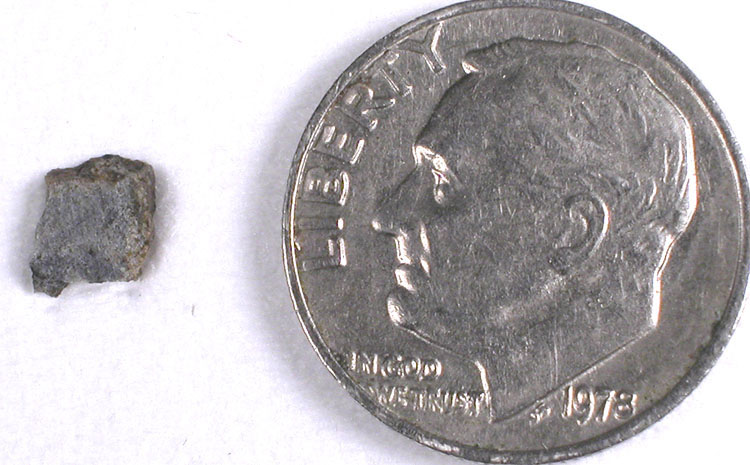
NWA 4881 is a lunar gabbro meteorite that contains two pyroxenes, olivine, plagioclase shocked to maskelynite, K, Ba feldspar, and various Cr, Fe, Ti oxides. This cumulate lunar rock (cumulate = accumulation of crystals by gravity settling in a magma) probably originated in the lunar highlands environment as a thick lava flow or as a shallow intrusive into the highlands crust. After formation, the gabbro was shocked by hypervelocity impact and sent hurtling toward Earth. Display boxes measure 2 3/16" x 1 3/8".
All weigh between 7 to 14 mg, and measure around 2 mm. Box designs vary (example shown).Moon rocks #MR-NWA4881
|
|
|